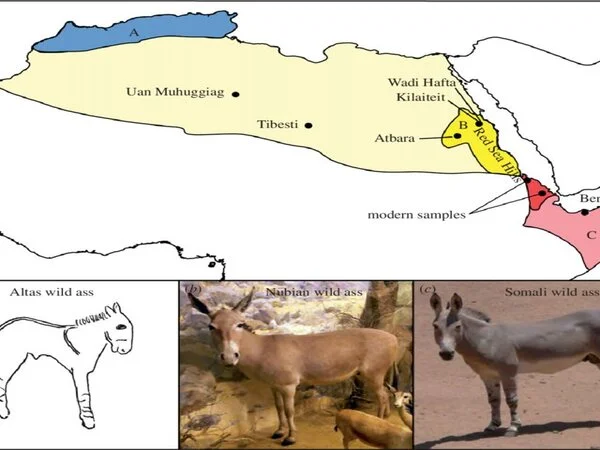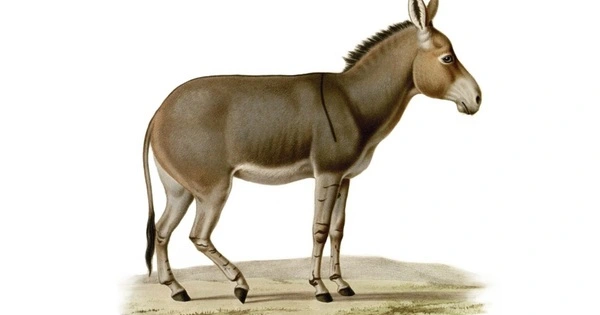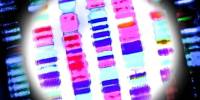Donkeys are frequently referred to as beasts of burden. A beast of burden is any animal that is used to pull or carry things. Pack animals are animals that are used to carry objects on their backs. Draft animals are animals that are used to pull things. The Khoekhoen were the first people in South Africa to use pack animals. Cattle were used to transport goods, to ride on, and to fight wars. When European settlers arrived in the 1600s, they used oxen to pull their wagons and ploughs.
Donkeys are descended from wild asses native to Africa and Asia. There were two types of wild ass in Africa: the Nubian wild ass in the north and the Somali wild ass in the east. Around 5000 years ago, donkeys were domesticated. Before camels arrived in Africa for the first time (from Arabia) in the third century, they were used as pack animals in the Sahara Desert. Donkeys arrived in South Africa for the first time in 1656, despite their African origins. They were used on farms as both pack and draft animals.
Donkeys have carried civilization on their backs for centuries, from pulling Mesopotamian war chariots to grinding grain in the Middle Ages. DNA analysis has revealed the true nature of ancient humans’ relationship with donkeys. Researchers report in Science that the genetic instruction books of over 200 donkeys from around the world show that these beasts of burden were domesticated around 7,000 years ago in East Africa.
The history of the donkey has perplexed scientists for years. Donkeys are extraordinary working animals that are essential to the livelihoods of millions of people around the globe. As humans, we owe a debt of gratitude to the domestic donkey for the role they play and have played in shaping society.
Ludovic Orlando
“The history of the donkey has perplexed scientists for years,” says Ludovic Orlando, a molecular archaeologist at France’s Centre Anthropobiology and Genomics. This discovery demonstrates that donkeys were domesticated in a single swoop approximately 3,000 years before horses.
DNA has great potential for unraveling humankind’s shared history with our animal companions. In 2021, Orlando and his colleagues used DNA from the bones of horses to track their domestication to the Eurasian steppes, in what’s now southwestern Russia, more than 4,200 years ago. But the history of donkeys (Equus asinus) had remained murky. Today, domesticated donkeys are found all over the globe. A dwindling number of wild asses in Asia and Africa — the closest wild relatives of donkeys — pointed toward one of those continents as the likely donkey homeland.
Archaeological evidence — including a 5,000-year-old Egyptian tablet depicting marching asses, sheep and cattle — zeroed in on Africa as the most probable contender. But genetic studies attempting to pin down when and where donkeys were domesticated have been largely inconclusive.

This was most likely due to a lack of donkey DNA from many parts of the world, according to Orlando. For example, no genomes of donkeys living south of the equator in Africa have been published to date. Orlando and his colleagues collected 207 genomes from donkeys living in 31 countries ranging from Brazil to China, as well as DNA from 31 donkeys living between 4,000 and about 100 years ago, to obtain a more diverse DNA sample.
By comparing these genomes with those of wild asses, the researchers found that all donkeys could trace their lineage back to a single domestication event in East Africa, perhaps in the Horn of Africa, around 5000 B.C. From there, domesticated donkeys spread to the rest of the continent and into Europe and Asia, where they formed genetically distinct groups based on region. Humans have now brought donkeys to nearly every continent on Earth, carrying their genetic legacy with them.
These results add new clarity to the story of donkey domestication, says Emily Clark, a livestock geneticist at the Roslin Institute at the University of Edinburgh. “Donkeys are extraordinary working animals that are essential to the livelihoods of millions of people around the globe,” she says. “As humans, we owe a debt of gratitude to the domestic donkey for the role they play and have played in shaping society.”
















